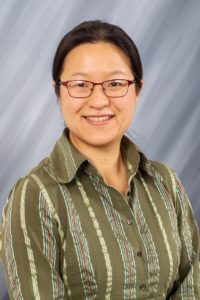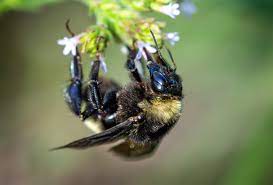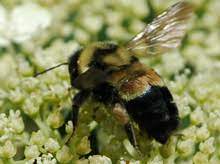Declining Bee Populations In Iowa Prompts Local Scientist To Ask Why
Dr. Ai Wen of the University of Northern Iowa works as an evolutionary and ecology researcher. Her broad research interests focus on wildlife and human interactions in agricultural ecosystems and the ecological services provided by pollinators that benefit humans. I recently sat down with her to ask her about her research, why certain pollinators are endangered and what farmers and landowners can do to foster the population growth of these species.
A Career Focused on the Benefits of Pollinators
 Vanya: It’s good to meet you Dr. Wen.
Vanya: It’s good to meet you Dr. Wen.
Dr. Wen: Thank you. It’s great meeting you too!
Vanya: Alright, to get things started, I’d like to inquire first about your research. Here at PFI, we work with farmers to make their operations the best they can be and a big part of that is supporting the ecological web that supports and sustains life at the base level. A big part of that is pollinators, which are critical to healthy agricultural systems. Can you briefly explain what your research focuses on and the benefits of that research?
Dr. Wen: Certainly. My research focuses primarily on pollinator populations on farms that have some mix of CRP or reconstructed prairie on horticulture farms. We had initially sought out those farms that had already established this type of habitat and had that in place for at least three years prior to us surveying it for pollinators. We then compare that to vegetable growers without these established habitats. When a survey is being conducted, the team is looking for types of pollinators, such as species, and how many of each species, as well as areas with higher pollinator density within the same farm. We’ve been surveying these farms since about 2016-2017.
Vanya: And what have you found so far on those farms?
Dr. Wen: Intuitively, we have found that those farms with established CRP were host to more pollinators and varying types of pollinators, such as bees, wasps and butterflies. My research primarily hones in on the bees, but these farms are more biologically diverse. Horticulture farms in general tend to be more pollinator friendly than conventional row crop farms, but those farms too, if they implement CRP and other conservation programs, can also become thriving habitat for pollinators. The landscape of just corn and soybean does provide some habitat, but it’s limited. Soybeans only “bloom” for about two weeks and corn is primarily a wind pollinated species, though it does produce some pollen that benefits bees. Establishing some type of alternative habitat is best on these types of acreages.
Vanya: Have you found any yield differences between those horticultural farms that hosted more pollinators than those without those habitats?
Dr. Wen: My research tends to focus more on the quantity and health of the individual bee species as opposed to farm outputs. However, we did find that even surrounding areas, such as adjacent farms, were host to more pollinators if they abutted the farm with the established habitat, so other horticultural farmers could benefit from this cross pollination of their crops from healthy bee populations nearby.
A Focus on Declining Bee Species
Vanya: For our northeast and north central members, we have a new cost-share program that will help establish habitat for several endangered
pollinator species, two of them being the American bumblebee and the Rusty Patch bumblebee. What can you tell me about those species?
Dr. Wen: (Laughs) None of these bees are very picky! We refer to them as generalists, which means that they don’t really require a very specific plant or anything to feed on, just general flower resources. There are certainly species that are much more particular about their food sources, but not these little guys. But what is important is that they have a continuous flow of resources throughout the seasons. Currently, our primary crops of corn and soybean that dominate Iowa are not meant for this kind of continuous supply of pollen or natural resources.
Vanya: You mentioned that corn and soybean fields are not an ideal environment for these species to take advantage of continuous pollen supplies throughout the warmer seasons. Given that over 80% of Iowa is held in some kind of production, with the primary crops being corn and soybean, what suggestions do you have for farm operators as to what practices they could implement on their farms to provide that more constant nectar resource?
Dr. Wen: I would say first and foremost, if chemical use, such as pesticides, can be reduced on a farm, then that should be step one. Of course, this may not be viable for every farm, and certainly no farmer sprays with the intent of harming pollinator populations, but it is a big reason for their decline here in Iowa.
Another thing farmers can do is strive to keep as many wild areas as possible on an acreage. Keep those ditches, hedgerows and overgrown fence lines as much as possible. Some programs like CRP can help with the cost of establishing native prairie plants in these places. Roadside plantings are also a great resource. Places where you are not able to physically farm or would not be profitable to farm are great places to help pollinators of all kinds.
Vanya: That’s great advice and something we really encourage for habitat implementation here at PFI; thank you for that. These two species, the American bumblebee and the Rusty Patch bumblebee, as well as many others that you are studying, have been on a steady decline for years now. Are there any places where they are doing well?
Dr. Wen: Yeah, they do surprisingly well in urban and suburban environments, although it may be no surprise at all. Residents in these areas tend to have gardens that can supply that continuous nectar source we spoke of earlier. There are also parks where cities and municipalities plant flowering trees. All of that makes suburban and urban areas an oasis for pollinators.
Vanya: If urban areas are like islands of plenty for these pollinators and more cities are taking up green initiatives, as well as these species being generalists and not picky about their nectar sources, why are their populations in such decline?
Dr. Wen: You just asked the million-dollar question, something people working in conservation have been wondering for quite a while now. Rusty patch bumblebees used to be the number one bumblebee found in surveys in the 1990s and then, for whatever reason, starting around 2000, they’re just gone in many places. Even with widespread pesticide use considered, these two species have declined faster than other generalist species. There is a type of mite (Varroa destructor) affecting many bee populations, but no one knows if even that mite is enough to be the determining factor. It should be noted though, that these mite numbers have increased simply because of all the shipping, the importing and exporting, of different bumblebees over the years.
Vanya: Is there anything biological or genetic that has been looked at that could explain the decline?
Dr. Wen: Not that we’ve found so far. They can’t cross breed with other bees, so the genetics are not being lost so to speak. I don’t think its any one factor but a multitude of them. Death by a thousand cuts. Pesticide and fungicide use, loss of spacious habitat, monocultures, parasites. All these can combine into a cacophony of symptoms that can’t be overcome. My best advice is to plant native gardens; reduce chemical use, if possible; and keep what areas can be wild, wild.
Vanya: Thank you, Dr. Wen, that’s great advice. Do you know what people such as farmers or homeowners can do if they want to see what types of bees and pollinators there are or if they think they’ve seen some of these endangered species?
Dr. Wen: Yes! There is a citizen science initiative called Bumblebee Watch where you can upload pictures of bumblebees you encounter for identification and to see if anyone else in your area has seen specific types of bees. There are great resources here on how to identify common bumblebees and report sightings.
Vanya: Alright, thank you so much for all your hard work in researching these bees for us and for taking the time to tell us about them today. We really appreciate it here at PFI and hope to hear of any updates you may have in the future regarding the state of our pollinators here in Iowa.
Dr. Wen: It was a pleasure. I really appreciate all the hard work PFI does, and I hope the next few years brings good news for our bees!


